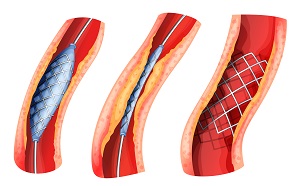Endovascular Management
 Patients that suffer from severe Peripheral Arterial Disease (PAD), may require endovascular treatment to alleviate or correct blood flow to the legs. Most procedures are non-invasive providing life giving blood flow to the arteries in the legs and surrounding tissues. Without proper circulation, the legs can be deprived of oxygen and blood to the point of starvation causing gangrene or limb loss. These are extreme examples; however, early diagnosis combined with proper treatment can easily prevent this worst case scenario. The most common PAD surgical procedures include the following:
Patients that suffer from severe Peripheral Arterial Disease (PAD), may require endovascular treatment to alleviate or correct blood flow to the legs. Most procedures are non-invasive providing life giving blood flow to the arteries in the legs and surrounding tissues. Without proper circulation, the legs can be deprived of oxygen and blood to the point of starvation causing gangrene or limb loss. These are extreme examples; however, early diagnosis combined with proper treatment can easily prevent this worst case scenario. The most common PAD surgical procedures include the following:
Types of Endovascular Procedures
- Angioplasty is considered to be minimally invasive in comparison to open surgery. It is most effective for more localized blockages in the larger arteries. During the angioplasty procedure, a long, thin, flexible tube called a catheter is inserted into a small puncture over an artery in the arm or groin. The catheter is guided through the arteries to the blocked area. Once in place, a special balloon, which is attached to the catheter, is inflated and deflated several times. The balloon pushes plaque in the artery against the artery walls to widening the vessel.
- Endovascular Stent Placement may be required for some patients who suffer from peripheral artery disease. During the procedure, a tiny mesh-metal tube, called a stent, is inserted into the narrowed area of an artery to keep it open. The stent remains permanently in the artery allowing blood to flow more freely through the artery.
- Endovascular Atherectomy is a minimally invasive surgical procedure that removes plaque from arteries and blood vessels in the body. Instead of pushing plaque into the walls of vessels and arteries, this technique completely removes plaque buildup. The most common access point is near the groin through the common femoral artery (CFA). Other common places are the brachial artery, radial artery, popliteal artery, and dorsalis pedis.







